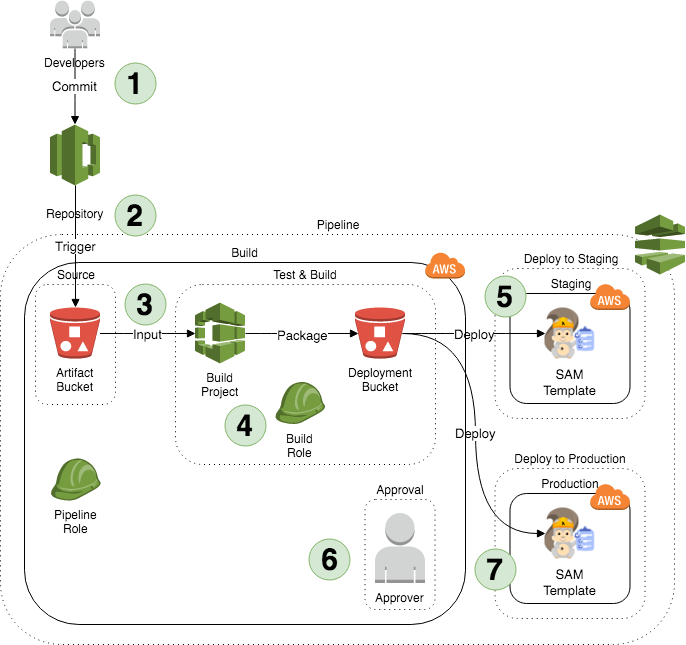This repository contains a serverless application, and multi-stage pipeline to perform CI/CD on it.
- Launch the deploy role template to the deploy accounts, passing the build account's id.
- Gather the cross-account role ARNs from the stacks' outputs.
- Deploy the pipeline and its dependencies template to the build account, passing the deploy role ARNs and other parameters.
- Get the repository URL from the pipeline's stack outputs.
- Push this repository's code to the repository to trigger a build and deployment to the staging account.
- Manually approve the deployment in to the production account.
- Profit!
Multiple accounts are used so that:
- Blast radius is limited. Issues in the deploy accounts cannot impact other deploy accounts.
- No runtime dependencies on the pipeline. The pipeline resources (and the associated resources) can be removed without impacting the running application.
While multiple accounts are part of the architecture, nothing is stopping you from using less accounts - just supply the same Account Id in multiple locations (e.g. when the pipeline and repo are in the production account). The same deployment role can be used for both the staging and production stages, and they can all be in the same account.
The recommend deployment pattern is a "pipline in production" approach This is based on the reasoning that anything that can modify production, is production:
Some setups involve the idea of a "build" environment, which is a production-like environment that is separate from the application's production environment (usually for administrative reasons).
This approach can also work, as long as appropriate controls are in place on the build environment:
A serverless application (using AWS SAM) template is
included to simulate a real-world application. The application consists of a
golang Lambda function (with tests), and API Gateway endpoint.
The application's build is managed via a CodeBuild
buildspec.yaml file. All of the tasks are managed via
make.
The accounts where the application will be deployed (e.g. staging and production). These accounts must have some resources deployed in them to facilitate the pipeline's access to deploy (e.g. cross-account role, etc).
- Changes are deploy to the same named stacks e.g.
ApplicationName-staging. - Changes are automatically applied to the staging stack.
- Manual approval is required before a change set is created in production, and before the change set is applied (i.e. there are two approvals required).
This high-level diagram represents the resources that are created by the
dependencies-tempalate.yaml.
- Developers push code.
- Pipeline is triggered by commits to
master. - A build container builds the source using
makecommands (defined inbuildspec.yaml). - Build artefacts are packaged and stored for deployment in S3 using
aws cloudformation package. - The change set is automatically deployed to the staging environment stack.
- The change must be manually approved before anything is deployed to production.
- The change set is applied to the production stack, and must then be approved again before it is deployed.
The following resources are created and referenced in the deploy accounts:
-
Building CI/CD Pipelines for Serverless Applications - SRV302 - re:Invent 2017 video
-
Building CI/CD Pipelines for Serverless Applications - SRV302 - re:Invent 2017 slides
-
All CodeBuild Docker images are on GitHub




